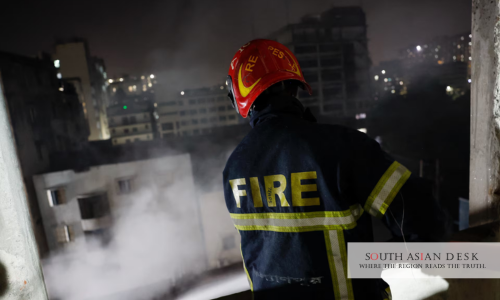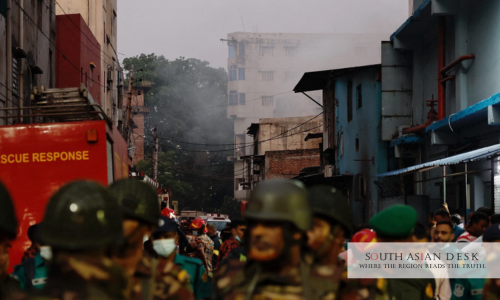A Bangladesh garment factory fire swept through a Dhaka building on Tuesday, killing 16 workers and leaving others missing amid choking gases from a nearby chemical store. The incident unfolded in Mirpur around noon. Officials blame safety lapses for the rapid spread.
Bangladesh garment factory fire exposes deep flaws in the ready-made garments sector that employs four million people and drives 84 per cent of exports. It stirs fears among South Asian workers reliant on similar low-cost manufacturing hubs. Neighbouring nations watch for ripple effects on regional labour standards.
Dhaka RMG Factory Fire Death Toll
Firefighters battled the Bangladesh garment factory fire for three hours before containing flames in the main structure. The blaze began on the third floor of a four-storey building in Mirpur’s Rupnagar area. It quickly engulfed an adjacent chemical warehouse stocked with bleaching powder, plastics, and hydrogen peroxide. Eight units from the Fire Service and Civil Defence responded at 11:40 am.

Rescue teams recovered 16 bodies by evening, mostly from the factory’s second and third floors. Officials identified seven women among the dead, all believed to be garment workers. Thirteen people remained unaccounted for as searches continued into the night. The wounded numbered at least five, treated for smoke inhalation at Dhaka Medical College Hospital.
Fire Service Director of Operations Lieutenant Colonel Md Tajul Islam Chowdhury addressed reporters. “The bodies were burned beyond recognition,” he said during a briefing. He noted recovery efforts persisted amid collapsed debris. Talha Bin Jashim, a senior fire official, cited witnesses who saw smoke billow from the warehouse first.
The Dhaka RMG factory fire death toll could climb further. Officials warned of structural risks in the seven-year-old building. Families gathered at the site, clutching photos of missing kin. One relative described frantic searches at the morgue. “I checked twice but found no trace of her,” a man told reporters outside the hospital.
Bangladesh Garment Worker Safety Reforms
Bangladesh garment worker safety reforms gained urgency after the factory fire. The sector faces scrutiny over repeated violations. Past disasters like the 2013 Rana Plaza collapse killed 1,134 and injured 2,500. That event spurred the Accord on Fire and Building Safety, signed by global brands.
Atiqur Rahman, deputy inspector general for the Department of Inspection for Factories and Establishments in Dhaka, inspected the site. “The fire originated in an illegal chemical warehouse,” he told media. His team flagged absent fire exits and poor ventilation. Rahman vowed probes into licensing lapses.
The Fire Service and Civil Defence posted updates on Facebook. Their statement detailed the 11:40 am alert and initial response. It highlighted toxic gas as a key killer, alongside a locked rooftop door that trapped workers. Officials blamed these for most fatalities.
Labour rights groups demanded swift action. The Bangladesh Garment Manufacturers and Exporters Association issued no immediate statement, but industry leaders historically pledge compliance audits. Reforms include mandatory sprinklers and evacuation drills, yet enforcement lags in 4,000-plus factories.
This Bangladesh garment factory fire underscores gaps in post-Rana Plaza gains. Annual inspections cover only 60 per cent of sites, per government data. Fines for violations total BDT 500 million yearly, but repeat offenders persist. Worker unions call for higher penalties and union rights in export zones.
South Asian parallels emerge. India’s textile hubs report similar fires, while Pakistan’s factories face union crackdowns. The Dhaka incident pressures Dhaka to align with International Labour Organization standards.
Investigators now sift rubble for clues. Preliminary findings point to electrical faults in the warehouse igniting chemicals. No arrests followed yet, but Rahman signalled potential charges for negligence.
Garment exports hit USD 47 billion last year, per official figures. Disruptions from such fires cost millions in lost output. Brands like H&M and Zara, reliant on Bangladeshi suppliers, monitor developments closely.
Background
Bangladesh garment factory fire fits a grim pattern. Since 2005, over 1,000 workers died in sector blazes. The RMG industry boomed post-1990s liberalisation, drawing FDI worth USD 3 billion annually. Yet, substandard buildings and cost-cutting plague operations.
Rana Plaza’s legacy birthed the Bangladesh Accord, now in its third iteration. It inspects 1,500 factories yearly. Despite progress, 2024 saw 20 fire incidents, injuring 200.
Global pressure mounts. The European Union eyes stricter rules under its sustainability pact. South Asian exporters risk tariffs without verified safety.
What’s Next
Authorities plan a full inquiry by month’s end. Expected outcomes include factory closures and BDT 100 million in compensation funds. Unions push for nationwide drills.
Bangladesh garment factory fire may accelerate reforms, but sustained enforcement remains key to preventing repeats.
Published in SouthAsianDesk, October 15th, 2025
Follow SouthAsianDesk on X, Instagram, and Facebook for insights on business and current affairs from across South Asia.






